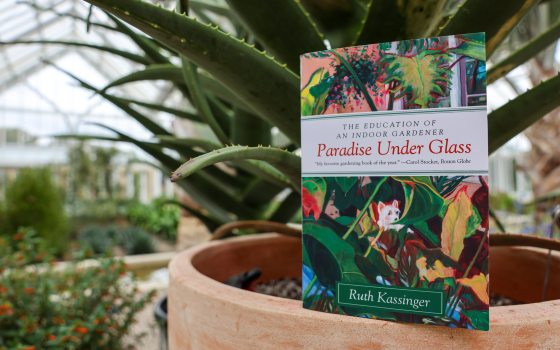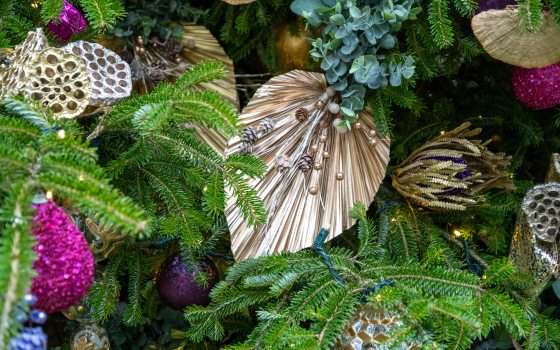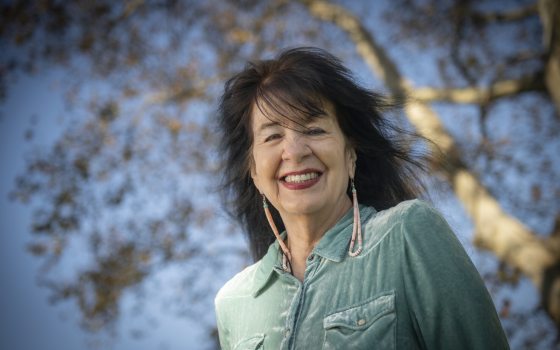It’s this time of the year where conservatories, or gardens under glass, are a true escape from the bitter winter. It’s a wondrous, relaxing adventure to stroll through these warm glasshouses filled with tropical and lush plants when there is snow and ice outside. Such a contrast, such a welcome reprieve. This year, we’re able to learn more about conservatories through our Community Read 2025 selection, Paradise Under Glass: The Education of an Indoor Gardener by Ruth Kassinger, which expertly weaves her unplanned adventure of building her own conservatory at her suburban Maryland home with learning the basics of gardening, exploring the history of conservatories, and navigating personal grief and loss. This beautiful story is an inspiration to those of us who consider ourselves terrible at gardening; it’s solace to those experiencing our own feelings of sadness or loss of control over our lives; and it’s a pure and lovely story we can just sit back and enjoy. I had the lovely pleasure to speak to Kassinger about her book, and the process of creating such a meaningful and impactful story.
This book was published in 2010—15 years ago. What is your conservatory like now? How has your indoor gardening evolved over the years?
I’m primarily a writer, and this was a fabulous adventure into the world of plants and conservatories. And I continued that when I wrote another book called Garden of Marvels, which is about how we discovered how plants work. That’s a lot more difficult than you would imagine. It was easier to discover how animals worked than it was to discover how plants worked. And then I continued along those lines when I wrote Slime about algae.
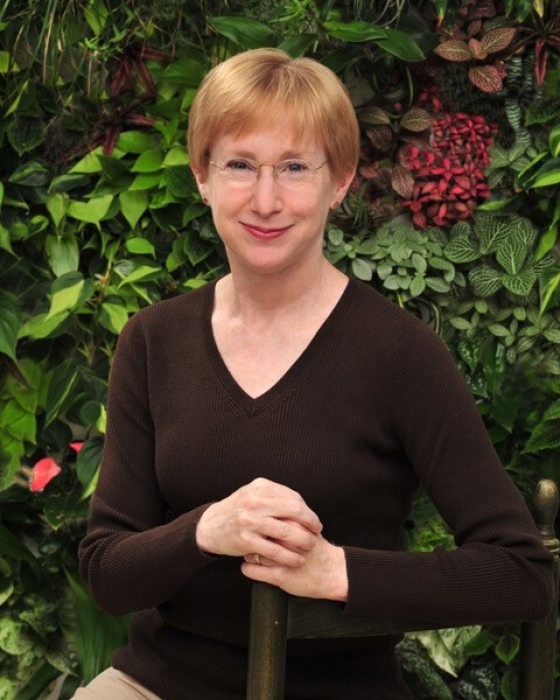
But you know, I’m truly a writer and gardening was a wonderful experience, but I’m on to other things now. I’m doing sculptures; musical instruments, transparent musical instruments, including a baby grand piano which is in our living room. Strung with 2,000 silk threads of different colors that represent music. So, for me, there’s always something.
You share many lessons you learned: the challenges, the success. What has stuck with you over these years? What would you do differently?
What would I do differently? I would think twice about the orientation of the conservatory. I didn’t know if it would fit so perfectly in the “L” of the house. But I was really handicapped by the fact that it was a one-story conservatory and the major part of the house was blocking light from the south. Even though it got five or six hours of good sunlight every day, it really wasn’t enough to grow some of the most beautiful flowering plants which need sunlight. So, I ended up using high-intensity overhead lamps, especially in the winter, to get flowers, plants, or trees to bloom and I was always a little hesitant about that. It didn’t seem right to use artificial light, electricity to grow these plants.
I think the things that meant most to me were growing trees with fruits or edible berries. I guess we’ve all felt this, but there’s something about the provision of homegrown food that is very appealing. I think it appeals to something deep inside us which is feeling that we should be that connected to nature that we can work with nature to produce something to sustain us. Whether it was oranges or limes or Buddha’s hands or coffee, those were really the most fun for me and gave me the most satisfaction.
The biggest challenge, I think, and this is probably true for all indoor gardeners, is insects, bugs. I somehow started off thinking oh, I won’t have to deal with any insects because my garden will be inside. But insects really, you know, don’t care about that. It just takes one to make it inside, and they don’t have any natural predators, and one becomes a million. That was a constant, constant struggle. I ended up getting beneficial bugs to combat the bad bugs but, especially indoors, that’s a lot of bugs.
Your book has many layers. You share the experience of building a conservatory onto your house, learning to garden indoors on a scale much larger than houseplants; you share your cancer diagnosis and the passing of your sister; and you also provide fascinating threads of the history of conservatories and gardens. How did you go about writing this? How did you gather these various threads to weave them into such a smooth, insightful story?
I didn’t set out thinking I was going to write a book. I really looked at this as consolation, an antidote to depression—both normal seasonal depression and having lost my sister, and just in general. It really was an adventure without any thought of making a book out of it.
But after I got into it, once I got my feet back on the ground and was going to return to good health, all of my professional interests and instincts kicked in. I’d written a number of books about various scientific subjects already. So, it was just my frame of mind. Fortunately, in the history of conservatories there’s a linear path; combined with a genuine interest in particular plants—the two kind of merged together.
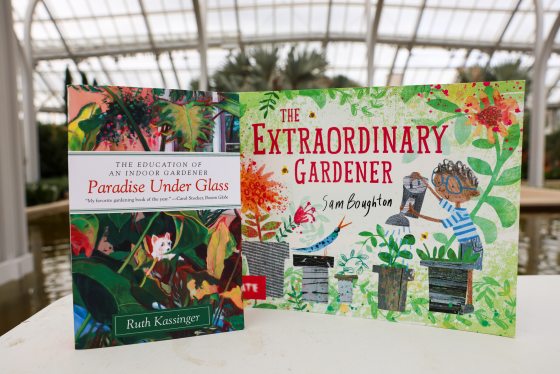
Our two 2025 Community Read selections, Paradise Under Glass: The Education of an Indoor Gardener by Ruth Kassinger, and our children’s selection—Sam Boughton’s picture book The Extraordinary Gardener, a beautifully illustrated story about a young boy seeking color in a dreary world. Both are available for purchase at The Garden Shop or The Garden Shop online. Photo by Carol Gross.
In recent years, mental health and wellness has become a larger topic in our society. In this book you share how building a conservatory helped you through times of personal challenges and grief. How has gardening continued to help you through difficult times?
For one, I think there’s a feeling of some control. When you’re a gardener, it’s not really difficult to be an okay gardener. You can put a bulb in a pot. It took me a while to figure out how to water properly. But you can do that. You can provide it sun, and it’s actually going to grow and bloom. Some depression—no, blueness—we have is when we feel things are out of our control. When you have children, you know they are not like plants. You can love them to death, but you can’t stop bad things from happening to them. So, there’s something about gardening that gave me a sense of control.
Also, home gardening is low stakes. This is one of the lessons I learned going to Florida and seeing those huge greenhouses where they’re producing plants by clones. And there are millions of the same plant stretching a football field. It reminds you not to get too attached to a plant. I think there is some psychological part of gardening that is satisfying that way, or helpful that way.
And then there’s the satisfaction of seeing something beautiful happen. There’s nothing like seeing a plant burst into bloom. Poets are often gardeners, and our hearts have forever been lifted by the beauty, the natural beauty, especially in winter, when you look out and you know the trees are bare and look like scrub, but then the produce something beautiful. That is spirit raising.
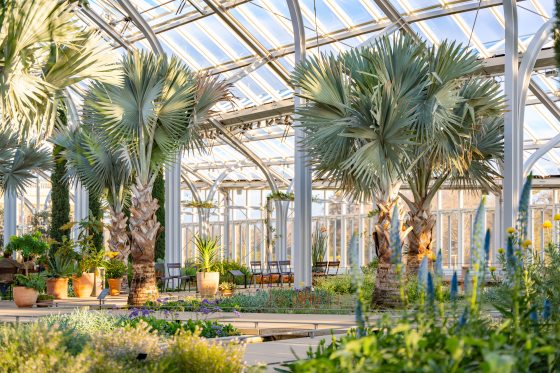
In Paradise Under Glass: The Education of an Indoor Gardener, Kassinger details her unlikely desire to build, stock, and tend a conservatory in her suburban Maryland home—and all she learned along the way. Pictured here is Longwood’s new West Conservatory, a crystalline structure encompassing a sprawling Mediterranean-inspired landscape. Photo by Holden Barnes.
Lastly, what do you hope readers learn from your story? What do you hope your book communicates to them?
I hope they enjoy it, the entertainment value. I had no idea that we can look to the ancient Romans for the beginning of conservatories, with their cool, cold frames. And then the whole pineapple story! Christopher Columbus is part of that story. Who knew that people raised pineapples in England in the 1700s?! I’m just hoping people have a good time reading the story.
Another lesson is if someone is completely a novice as I was, they know they can learn to grow plants indoors. Anyone can! I’m hoping it will inspire people to get more indoor plants and experience the fun of growing them, and also to not be upset. The natural habitats for these plants are tropical, and we live in the northern latitudes. So of course it’s not always going to be successful. It’s not anybody’s fault, it’s just that they’re not meant to be here.
Also, try new things and be willing to fail and make a fool of yourself. I was. I built this whole conservatory! What would happen if I couldn’t grow any plants? That would be ridiculous, I’d be embarrassed. But embarrassment—potential embarrassment—should not rule our lives.
That’s part of the Ruth Kassinger thing, you know. It sounds crazy to make a transparent piano, and I’m doing it in the middle of my living room, where everybody can see if it’s a total failure. But what’s the worst that’s going to happen? Nothing. So, give it a try. It’s a tremendous learning experience, whatever you’re setting out to do. It’s another way to combat sadness, the ‘yikes! I’m getting older, life isn’t forever’ feeling. I didn’t do it consciously, but maybe that’s something someone will be left with—how Ruth could’ve made a total mess of this, could’ve been a real failure, but she did it anyway … and she did it.
Editor’s note: Hear more from Kassinger during our Creating Paradise with Ruth Kassinger event on March 29. Join us online or in our Conservatory Ballroom for this inspiring discussion and have the opportunity to ask questions. For those joining us in-person, the event is free with Gardens Admission; following the talk, join us for a book signing with Kassinger and an opportunity to continue the conversation in an informal setting with a light dessert reception.
Now in its twelfth year, our Community Read brings books and people together to spur discussion about an important idea or topic.
